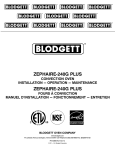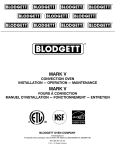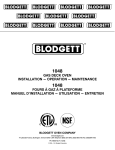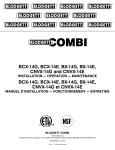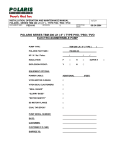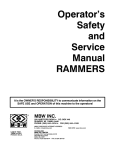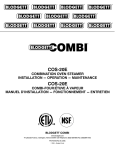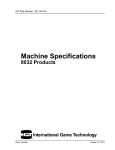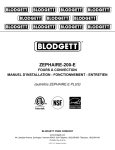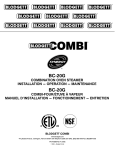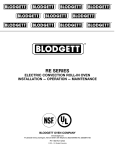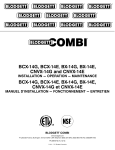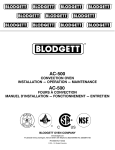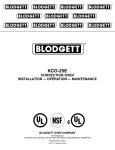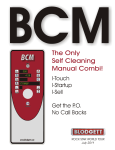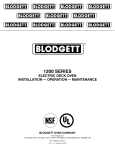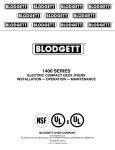Download Blodgett ZEPHAIRE-G Specifications
Transcript
ZEPHAIREĆG CONVECTION OVEN INSTALLATION - OPERATION - MAINTENANCE ZEPHAIREĆG FOURS À CONVECTION MANUEL D'INSTALLATION - FONCTIONNEMENT - ENTRETIEN BLODGETT OVEN COMPANY www.blodgett.com 44 Lakeside Avenue, Burlington, Vermont 05401 USA Telephone (800) 331Ć5842, (802) 860Ć3700 Fax: (802)864Ć0183 PN 90139 Rev K (4/09) E 2009 - G.S. Blodgett Corporation IMPORTANT WARNING: IMPROPER INSTALLATION, ADJUSTMENT, ALTERATION, SERVICE OR MAINTENANCE CAN CAUSE PROPERTY DAMAGE, INJURY OR DEATH. READ THE INSTALLATION, OPERATING AND MAINTENANCE INSTRUCTIONS THOROUGHLY BEFORE INSTALLING OR SERVICING THIS EQUIPMENT AVERTISSEMENT: UNE INSTALLATION, UN AJUSTEMENT, UNE ALTÉRATION, UN SERVICE OU UN ENTRETIEN NON CONFORME AUX NORMES PEUT CAUSER DES DOMMAGES À LA PROPRIÉTE, DES BLESSURES OU LA MORT. LISEZ ATTENTIVEĆ MENT LES DIRECTIVES D'INSTALLATION, D'OPÉRATION ET D'ENTRETIEN AVANT DE FAIRE L'INSTALLATION OU L'ENTRETIEN DE CET ÉQUIPEMENT. INSTRUCTIONS TO BE FOLLOWED IN THE EVENT THE USER SMELLS GAS MUST BE POSTED IN A PROMINENT LOCATION. THIS INFORMATION MAY BE OBTAINED BY CONTACTING YOUR LOCAL GAS SUPPLIER. LES INSTRUCTIONS À RESPECTER AU CAS OÙ L'UTILISATEUR PERÇOIT UNE ODEUR DE GAZ DOIVENT ÊTRE AFFICHÉES DANS UN ENDROIT BIEN VISIBLE. VOUS POUVEZ VOUS LES PROCURER AUPRÈS DE VOTRE FOURNISSEUR DE GAZ LOCAL. FOR YOUR SAFETY Do not store or use gasoline or other flammable vapors or liquids in the vicinity of this or any other appliance. AVERTISSEMENT Ne pas entreposer ni utiliser de l'essence ni d'autres vapeurs ou liquides inflamĆ mables dans le voisinage de cet appariel, ni de tout autre appareil. The information contained in this manual is important for the proper installation, use, and maintenance of this oven. Adherence to these procedures and instrucĆ tions will result in satisfactory baking results and long, trouble free service. Please read this manual carefully and retain it for future reference. Les informations données dans le présent manuel sont importantes pour installer, utiliser et entretenir correctement ce four. Le respect de ces instructions et procéĆ dures permettra d'obtenir de bons résultats de cuisson et une longue durée de serĆ vice sans problèmes. Veuillez lire le présent manuel et le conserver pour pouvoir vous y reporter à l'avenir. Errors: Descriptive, typographic or pictorial errors are subject to correction. SpecificaĆ tions are subject to change without notice. Erreurs: Les erreurs de description, de typographie ou d'illustration font l'objet de corrections. Les caractéristiques sont sujettes à modifications sans préavis. THE REPUTATION YOU CAN COUNT ON UNE RÉPUTATION SUR LAQUELLE VOUS POUVEZ COMPTER For over a century and a half, The Blodgett Oven Company has been building ovens and nothing but ovens. We've set the industry's quality standard for all kinds of ovens for every foodservice operation regardless of size, application or budget. In fact, no one offers more models, sizes, and oven applications than Blodgett; gas and electric, fullĆsize, halfĆsize, countertop and deck, conĆ vection, Cook'n Hold, CombiĆOvens and the industry's highest quality Pizza Oven line. For more information on the full line of Blodgett ovens contact your Blodgett representative. Cela fait maintenant dessus un siècle et demi que Blodgett se spécialise dans la fabrication de fours. Nous avons établi les normes de qualité qui s'appliĆ quent dans l'industrie à tous les types de fours utilisés dans les services aliĆ mentaires, quel qu'en soit la taille, l'exploitation ou le budget. En fait, ni n'offre plus de modèles, de tailles et d'applications de fours que Blodgett. À gaz et électriques. De tailles différentes, sur plan de travail et superposables. Qu'il s'agisse de fours à convection, des modèles Cook'n Hold et CombiĆOven, ou de la gamme de fours à pizzas de la plus haute qualité offerte sur le marché. Pour de plus amples informations sur la gamme complète de fours Blodgett, veuillez contacter votre représentant Blodgett. Model/Modèl: Your Service Agency's Address: Adresse de votre agence de service: Serial Number/Numéro de série: Your oven was installed by/ Installateur de votre four: Your oven's installation was checked by/ Contrôleur de l'installation de votre four: Table of Contents/ Table des Matières Introduction Introduction Oven Description and Specifications . . . . 2 Description et Spécifications du Four . . . . 26 Oven Components . . . . . . . . . . . . . . . . . . . . 3 Éléments du Four . . . . . . . . . . . . . . . . . . . . . 27 Installation Installation Delivery and Location . . . . . . . . . . . . . . . . . 4 Livraison et Implantation . . . . . . . . . . . . . . . 28 Oven Assembly . . . . . . . . . . . . . . . . . . . . . . 5 Montage du Four . . . . . . . . . . . . . . . . . . . . . 29 NSF Bolts . . . . . . . . . . . . . . . . . . . . . . . . . . 5 Boulons NSF . . . . . . . . . . . . . . . . . . . . . . . 29 Leg Attachment . . . . . . . . . . . . . . . . . . . . . 6 Assemblage des Pieds . . . . . . . . . . . . . . . 30 Caster Assembly . . . . . . . . . . . . . . . . . . . . 6 Montage des Roulettes . . . . . . . . . . . . . . 30 Double Section Assembly . . . . . . . . . . . . 7 Montage de la Section Double . . . . . . . . 31 Oven Leveling . . . . . . . . . . . . . . . . . . . . . . 7 Mise à Niveau du Four . . . . . . . . . . . . . . . 31 Ventilation . . . . . . . . . . . . . . . . . . . . . . . . . . . 8 Ventilation . . . . . . . . . . . . . . . . . . . . . . . . . . . 32 Canopy Type Exhaust Hood . . . . . . . . . . 8 Hotte D'évacuation Type Voûte . . . . . . . 32 Direct Flue Arrangement . . . . . . . . . . . . . 9 En Prise Directe . . . . . . . . . . . . . . . . . . . . . 33 Utility Connections Standards and Codes . . . . . . . . . . . . . . . . . 10 Branchements de Service - Normes et Codes . . . . . . . . . . . . . . . . . . . . . . . . . . . . . . . 34 Gas Connection . . . . . . . . . . . . . . . . . . . . . . 11 Branchement de Gaz . . . . . . . . . . . . . . . . . 35 Electrical Connection . . . . . . . . . . . . . . . . . 14 Raccordement Électrique . . . . . . . . . . . . . . 38 Initial Startup . . . . . . . . . . . . . . . . . . . . . . . . . 15 Mise en Marche Initiale . . . . . . . . . . . . . . . . 39 Operation Utilisation Safety Information . . . . . . . . . . . . . . . . . . . . 16 Informations de Sécurité . . . . . . . . . . . . . . . 40 Single Speed Blower . . . . . . . . . . . . . . . . . . 17 Soufflerie Une Vitesse . . . . . . . . . . . . . . . . . 41 Single Speed Blower with Cavity Lights . . 18 Soufflerie Une Vitesse avec Lumières de Cavité . . . . . . . . . . . . . . . . . . . . . . . . . . . . . . . 42 Dual Speed Blower . . . . . . . . . . . . . . . . . . . 19 Dual Speed Blower with Cavity Lights . . . 20 General Guidelines for Operating Personnel . . . . . . . . . . . . . . . . . . . . . . . . . . . . 21 Suggested Times and Temperatures . . . . 22 Maintenance Cleaning and Preventative Maintenance . 23 Troubleshooting Guide . . . . . . . . . . . . . . . . 24 Soufflerie Deux Vitesses . . . . . . . . . . . . . . . 43 Soufflerie Deux Vitesses avec Lumières de Cavité . . . . . . . . . . . . . . . . . . . . . . . . . . . . . . . 44 Consignes Générales à l'Intention des Utilasateurs . . . . . . . . . . . . . . . . . . . . . . . . . . 45 Durées et Températures Suggérées . . . . . 46 Entretien Nettoyage et Entretien Préventif . . . . . . . . 47 Guide de Détection des Pannes . . . . . . . . 48 Introduction Oven Description and Specifications Cooking in a convection oven differs from cooking in a conventional deck or range oven since heated air is constantly recirculated over the product by a fan in an enclosed chamber. The moving air conĆ tinually strips away the layer of cool air surroundĆ ing the product, quickly allowing the heat to peneĆ trate. The result is a high quality product, cooked at a lower temperature in a shorter amount of time. Blodgett convection ovens represent the latest adĆ vancement in energy efficiency, reliability, and ease of operation. Heat normally lost, is recircuĆ lated within the cooking chamber before being vented from the oven: resulting in substantial reĆ ductions in energy consumption and enhanced oven performance. Air Flow Pattern for Blodgett Convection Ovens Figure 1 GAS SPECIFICATIONS Natural Gas Propane Gas US Units SI Units US Units SI Units 1000 BTU/cu. ft. 37.3 MJ/m3 2550 BTU/cu. ft. 95.0 MJ/m3 0.63 0.63 1.53 1.53 3.5" W.C. .87 kPa 10" W.C. 2.49 kPa 60,000 BTU/hr 17.6 kW 60,000 BTU/hr 17.6 kW Main Burner Orifice Size .1065" dia. 2.7 mm .0635" dia. 1.6 mm Pilot Burner Orifice Size .021" dia. .53 mm .014" dia. .36 mm Heating Value Specific Gravity (air=1.0) Gas Manifold Pressure Oven Input GAS SPECIFICATIONS - Zephaire GĆL for Australia Oven Input Main Burner Orifice Size - 63 MJ/h - 63 MJ/h .1065" dia. 2.7 mm .0635" dia. 1.6 mm 2 Introduction Oven Components Combustion Cover - provides access to the combustion compartment on gas ovens. Rack Supports - hold oven racks. Blower Wheel Cover - located on the back interiĆ or wall of the oven. Protects the blower wheel. Combustion Compartment - contains combusĆ tion burners on gas ovens. Blower Wheel - spins to circulate hot air in the baking chamber. Combustion Burners - provide heat to the bakĆ ing chamber on gas ovens. Convection Motor - provides power to turn the blower wheel. Control Panel - contains wiring and components to control the oven operation. Oven Lights - provide lighting inside the baking compartment. Oven Racks - five racks are provided standard. Additional racks are available. Oven Lights Blower Wheel Convection Motor Blower Wheel Cover Rack Support Control Panel Oven Rack Combustion Cover Combustion Burners Figure 2 3 Installation Delivery and Location DELIVERY AND INSPECTION It is essential that an adequate air supply to the oven be maintained to provide a sufficient flow of combustion and ventilation air. All Blodgett ovens are shipped in containers to prevent damage. Upon delivery of your new oven: D D D Inspect the shipping container for external damĆ age. Any evidence of damage should be noted on the delivery receipt which must be signed by the driver. Uncrate the oven and check for internal damĆ age. Carriers will accept claims for concealed damage if notified within fifteen days of delivery and the shipping container is retained for inĆ spection. D D The Blodgett Oven Company cannot assume responsibility for loss or damage suffered in transit. The carrier assumed full responsibility for delivery in good order when the shipment was accepted. We are, however, prepared to assist you if filing a claim is necessary. D Before making any utility connections to this oven, check the rating plate to be sure the oven specifiĆ cations are compatible with the gas and electrical services supplied for the oven. OVEN LOCATION The well planned and proper placement of your oven will result in long term operator convenience and satisfactory performance. 1. Remove the combustion compartment cover. The rating plate is attached to the frame on the left side of the combustion compartment. The following clearances must be maintained beĆ tween the oven and any combustible or nonĆcomĆ bustible construction. D D D D Oven body right side - 6" (15 cm) Oven body left side - 6" (15 cm) Oven body back - 6" (15 cm) Oven body bottom - 4.5" (11.4 cm) The following clearances must be available for serĆ vicing. D D Place the oven in an area that is free of drafts. Keep the oven area free and clear of all combusĆ tibles such as paper, cardboard, and flammable liquids and solvents. Do not place the oven on a curb base or seal to a wall. This will restrict the flow of air and prevent proper ventilation. Tripping of the blower moĆ tor's thermal overload device is caused by an excessive ambient temperature on the right side of the oven. This condition must be corĆ rected to prevent permanent damage to the oven. The location must provide adequate clearance for the air opening into the combustion chamĆ ber. Oven body sides - 12" (30 cm) Oven body back - 12" (30 cm) NOTE: On gas models, routine servicing can usuĆ ally be accomplished within the limited movement provided by the gas hose reĆ straint. If the oven needs to be moved furĆ ther from the wall, the gas must first be turned off and disconnected from the oven before removing the restraint. Reconnect the restraint after the oven has been reĆ turned to its normal position. 4 Installation Oven Assembly NSF BOLTS any holes in stacked units not used for mountĆ ing stacking brackets. 1. Locate the 5/16" bolts that were shipped with the oven. 2. Install the bolts as shown in Figure 3. D These bolts are required by NSF to block any exĆ posed hole on the back of an oven. This includes: D any unit, single or stacked, without a back panel. Double Stacked Units Units without back panels Figure 3 5 Installation Oven Assembly LEG ATTACHMENT 1. Lay the oven on its back. 2. Align the threaded stud in each leg with the nut located inside each bottom corner of the oven frame. Turn the legs clockwise and tightĆ en to the nearest full turn. 3. Align the two leg plate holes in each leg with those in the oven bottom. Secure each leg usĆ ing two 1/2" bolts. NOTE: If using casters see CASTER ASĆ SEMBLY before proceeding. 4. Tip the oven up on the legs. 5. Level the oven by screwing the adjustable leg feet in or out as necessary. CASTER ASSEMBLY NOTE: Install the locking casters on the front of the oven. Install the nonĆlocking casters on the back of the oven. NOTE: Use a gas hose restraint on all units with casters. See page 13. Casters for Single and Double Stacked Ovens: 1. Attach the legs as described. 2. Pry the adjustable feet out of the legs. 3. Insert one caster into each leg as shown. Tighten the lock nuts to secure the casters. Adjustable Leg Foot Gas Hose Restraint Bracket Caster Assembly Figure 5 Low Profile Casters for Double Stacked Ovens: 1. Align the three holes in each caster assembly plate with those in the oven bottom. Secure each caster using three 1/2" bolts. 6" (15 cm) Legs Shown Figure 4 Gas Hose Restraint Bracket Figure 6 6 Installation Oven Assembly DOUBLE SECTION ASSEMBLY 3. Attach the stacking brackets using the reĆ maining 5/16" bolts shipped with the ovens. 4. Drill a clearance hole for a 5/16" bolt in the angle iron of the old style oven. Use the holes in the stacking brackets as a pilot. 5. Attach the stacking brackets to the old style oven with the 5/16" bolts and nuts provided in the kit. 6. Attach the flue connector. NOTE: Old style ovens refer to units with painted exĆ posed rear angle. New style ovens refer to units with rear angle iron enclosed in steel. The following instructions apply to stacking two new style ovens. 1. Secure the short legs to the bottom sections as described. 2. Place the upper section in position on top of the lower oven. 3. Attach the stacking brackets using the reĆ maining 5/16" bolts shipped with the ovens. 4. Attach the flue connector. WARNING!! When stacking ovens be sure to remove the single oven flue boxes prior to attachĆ ing threeĆpiece connector. The following instructions apply to stacking a new style oven on an old style oven. OVEN LEVELING 1. Secure the short legs to the bottom sections as described. 2. Place the upper section in position on top of the lower oven. After assembly, the oven should be leveled and moved to the operating location. 1. The oven can be leveled by adjusting the feet or casters located on the bottom of each leg. Flue Connector Figure 7 7 Installation Ventilation CANOPY TYPE EXHAUST HOOD On gas models the installation of a proper ventilaĆ tion system cannot be over emphasized. This sysĆ tem removes unwanted vapors and products of combustion from the operating area. A mechanically driven, canopy type exhaust hood is the preferred method of ventilation. The hood should be sized to completely cover the equipment plus an overhang of at least 6" (15 cm) on all sides not adjacent to a wall. The distance from the floor to the lower edge of the hood should not exceed 7' (2.1m). This oven may be vented using either: D D A mechanically driven, canopy type, exhaust hood, or A direct flue arrangement. The total makeup and exhaust air requirements for hood capacity should be approximately 30 CFM (.85 m3) for each oven section. U.S. and Canadian installations Refer to your local ventilation codes. In the abĆ sence of local codes, refer to the National ventilaĆ tion code titled, Standard for the Installation of Equipment for the Removal of Smoke and Grease Laden Vapors from Commercial Cooking EquipĆ ment", NFPAĆ96ĆLatest Edition. Installing the canopy hood draft diverter Ovens ordered for hood venting are supplied with a draft diverter. Install the draft diverter as follows: 1. Place the diverter over the flue connector with the open area facing the front of the oven. See Figure 8. 2. Secure both ends with the sheet metal screws provided. Australia and general export installations Installation must conform with Local and National installation standards. Local installation codes and/or requirements may vary. If you have any questions regarding the proper installation and/or operation of your Blodgett oven, please contact your local distributor. If you do not have a local disĆ tributor, please call the Blodgett Oven Company at 0011Ć802Ć860Ć3700. Draft Diverter WARNING: Failure to properly vent the oven can be hazardous to the health of the operator and may result in operational problems, unsatisfactory baking and possible damĆ age to the equipment. Damage sustained as a direct result of imĆ proper ventilation will not be covered by the manufacturer's warranty. Front of Oven Figure 8 8 Installation Ventilation DIRECT FLUE ARRANGEMENT Installing the draft hood When the installation of a mechanically driven exĆ haust hood is impractical the oven may be vented by a direct flue arrangement. Ovens ordered for direct venting are supplied with a draft hood. Install the draft hood as follows: 1. Place the draft hood over the flue connector. See Figure 9. 2. Secure both ends with the sheet metal screws provided. WARNING!! It is essential that the direct flue be installed as follows. Incorrect installation will result in unsatisfactory baking and oven damage. Flue The flue must be class B or better with a diameter of 6" (15 cm). The height of the flue should rise 6Ć8 ft (2Ć2.5 m) above the roof of the building or any proximate structure. Never direct vent the oven into a hood. The flue should be capped with a UL Listed type vent cap to isolate the unit from exterĆ nal environmental conditions. Draft Hood The direct vent cannot replace air consumed and vented by the oven. Provisions must be made to supply the room with sufficient makeĆup air. Total makeĆup air requirements for each oven section should be approximately 30 CFM (.85m3) per secĆ tion. To increase the supply air entering the room, a ventilation expert should be consulted. Front of Oven Figure 9 9 Installation Utility Connections - Standards and Codes THE INSTALLATION INSTRUCTIONS CONĆ TAINED HEREIN ARE FOR THE USE OF QUALIĆ FIED INSTALLATION AND SERVICE PERSONNEL ONLY. INSTALLATION OR SERVICE BY OTHER THAN QUALIFIED PERSONNEL MAY RESULT IN DAMAGE TO THE OVEN AND/OR INJURY TO THE OPERATOR. Qualified installation personnel are individuals, a firm, a corporation, or a company which either in person or through a representative are engaged in, and responsible for: D D the installation or replacement of gas piping and the connection, installation, repair or servĆ icing of equipment. the installation of electrical wiring from the elecĆ tric meter, main control box or service outlet to the electric appliance. Qualified installation personnel must be experiĆ enced in such work, familiar with all precautions required, and have complied with all requirements of state or local authorities having jurisdiction. 10 U.S. and Canadian installations Installation must conform with local codes, or in the absence of local codes, with the National Fuel Gas Code, NFPA54/ANSI Z223.1-Latest Edition, the Natural Gas Installation Code CAN/CGAĆ B149.1 or the Propane Installation Code, CAN/ CGAĆB149.2 as applicable. Installation must conform with local codes, or in the absence of local codes, with the National ElecĆ trical Code, ANSI/NFPA 70-Latest Edition and/or Canadian National Electric Code C22.2 as applicaĆ ble. Appliance is to be installed with backflow prevenĆ tion in accordance with applicable federal, provĆ ince and local codes. Australia and general export installations Installation must conform with Local and National installation standards. Local installation codes and/or requirements may vary. If you have any questions regarding the proper installation and/or operation of your Blodgett oven, please contact your local distributor. If you do not have a local disĆ tributor, please call the Blodgett Oven Company at 0011Ć802Ć860Ć3700. Installation Gas Connection GAS PIPING A properly sized gas supply system is essential for maximum oven performance. Piping should be sized to provide a supply of gas sufficient to meet the maximum demand of all appliances on the line without loss of pressure at the equipment. Example: NOTE: BTU values in the following example are for natural gas. You purchase a ZephaireĆG convection oven to add to your existing cook line. 1. Add the BTU rating of your current appliances. Pitco Fryer 120,000 BTU 6 Burner Range 60,000 BTU Deck Oven 50,000 BTU Total 230,000 BTU 2. Add the BTU rating of the new oven to the toĆ tal. Previous Total 230,000 BTU ZephaireĆG 60,000 BTU New Total 290,000 BTU 3. Measure the distance from the gas meter to the cook line. This is the pipe length. Let's say the pipe length is 40' (12.2 m) and the pipe size is 1" (2.54 cm). 4. Use the appropriate table to determine the toĆ tal capacity of your current gas piping. The total capacity for this example is 320,000 BTU. Since the total required gas pressure, 290,000 BTU is less than 320,000 BTU, the current gas piping will not have to be inĆ creased. NOTE: The BTU capacities given in the tables are for straight pipe lengths only. Any elbows or other fittings will decrease pipe capaciĆ ties. Contact your local gas supplier if you have any questions. Maximum Capacity of Iron Pipe in Cubic Feet of Natural Gas Per Hour (Pressure drop of 0.5 Inch W.C.) Nominal Size, Inches Pipe p Length L th (ft) 3/4" 1" 10 360 680 1400 2100 3950 20 250 465 950 1460 2750 30 200 375 770 1180 2200 40 170 320 660 990 1900 50 151 285 580 900 1680 60 138 260 530 810 1520 70 125 240 490 750 1400 80 118 220 460 690 1300 90 110 205 430 650 1220 100 103 195 400 620 1150 1Ć1/4" 1Ć1/4" 2" From the National Fuel Gas Code Part 10 Table 10Ć2 Maximum Capacity of Pipe in Thousands of BTU/hr of Undiluted L.P. Gas at 11" W.C. (Pressure drop of 0.5 Inch W.C.) p Length g Pipe (ft) Outside Diameter, Inches 3/4" 1" 1Ć1/2" 10 608 1146 3525 20 418 788 2423 30 336 632 1946 40 287 541 1665 50 255 480 1476 60 231 435 1337 70 215 404 1241 80 198 372 1144 90 187 351 1079 100 175 330 1014 From the National Fuel Gas Code Part 10 Table 10Ć15 11 Installation Gas Connection PRESSURE REGULATION AND TESTING ZephaireĆG ovens are rated at 60,000 BTU/Hr. (17.6 kW) (63 MJ) per section. Each oven has been adjusted at the factory to operate with the type of gas specified on the rating plate. DO NOT INSTALL AN ADDITIONAL REGULATOR WHERE THE OVEN CONNECTS TO THE GAS SUPPLY UNLESS THE INLET PRESSURE IS ABOVE MAXIMUM. Inlet Pressure Natural Propane Min Max Min Max W.C. 7.0 10.5 11.0 13.0 kPa 1.43 2.61 2.74 3.23 Prior to connecting the oven, gas lines should be thoroughly purged of all metal filings, shavings, pipe dope, and other debris. After connection, the oven should be checked for correct gas pressure. Manifold Pressure D D D D Natural Propane W.C. 3.5 10.0 kPa .87 2.49 Each oven is supplied with a regulator to maintain the proper gas pressure. The regulator is essenĆ tial to the proper operation of the oven and should not be removed. It is preset to provide the oven with 3.5" W.C. (0.87 kPa) for natural gas and 10.5" W.C. (2.50 kPa) for Propane at the manifold. The oven and its individual shutoff valve must be disconnected from the gas supply piping system during any pressure testing of that system at test pressures in excess of 1/2 psig (3.45kPa). Inlet Pressure - the pressure of the gas before it reaches the oven. Manifold Pressure - the pressure of the gas as it enters the main burner(s). Min - the minimum pressure recommended to operate the oven. Max - the maximum pressure at which the manufacturer warrants the oven's operation. The oven must be isolated from the gas supply piping system by closing its individual manual shutoff valve during any pressure testing of the gas piping system at test pressures equal or less than 1/2 psig (3.45kPa). Gas Connection 2.5" (64 mm) Gas Connection 3.75" (86 mm) Figure 10 12 Installation Gas Connection GAS HOSE RESTRAINT If the oven is mounted on casters, a commercial flexible connector with a minimum of 3/4" (1.9 cm) inside diameter must be used along with a quick connect device. The restraint, supplied with the oven, must be used to limit the movement of the unit so that no strain is placed upon the flexible connector. With the restraint fully stretched the connector should be easy to install and quick connect. The restraint (ie: heavy gauge cable) should be 1,000 lb. (453 kg) test load and should be attached without damaging the building. DO NOT use the gas piping or electrical conduit for the attachment of the permanent end of the restraint! Use anchor bolts in concrete or cement block. On wooden walls, drive hi test wood lag screws into the studs of the wall. 1. Mount the supplied bracket to the leg bolt just below the gas inlet. See Figure 11. 2. Attach the clip on restraining cable to the mounting bracket. Back of Oven Restraint Cable Bracket Double stacked unit shown. Use the same procedure for single units with 25" (64 cm) legs. Figure 11 13 WARNING!! If the restraint is disconnected for any reason it must be reconnected when the oven is returned to its original position. U.S. and Canadian installations The connector must comply with the Standard for Connectors for Movable Gas Appliances, ANSI Z21.69 or Connectors For Moveable Gas ApĆ pliances CAN/CGAĆ6.16ĆM87 and a quick disconĆ nect device that complies with the Standard for QuickĆDisconnect Devices for Use With Gas Fuel, ANSI Z21.41 or Quick Disconnect For Use With Gas Fuel CAN 1Ć6.9. Adequate means must be provided to limit the movement of the appliance without depending on the connection and the quick disconnect device or its associated piping. Australia and general export installations The restraint and quick connect must conform with Local and National installation standards. LoĆ cal installation codes and/or requirements may vary. If you have any questions regarding the propĆ er installation and/or operation of your Blodgett oven, please contact your local distributor. If you do not have a local distributor, please call the Blodgett Oven Company at 0011Ć802Ć860Ć3700. Installation Electrical Connection Wiring diagrams are located in the control compartment and on the back of the oven. WARNING!! This appliance is equipped with three prong grounding type plug for your protection against shock hazard and should be plugged directly into a properly grounded three prong receptacle. DO NOT cut or remove the grounding prong from this plug. This oven is supplied for connection to 115 volt grounded circuits. The electric motor, indicator lights and related switches are connected through the 6' electric supply cord found at the rear of the oven. THE BLODGETT OVEN COMPANY CANNOT ASĆ SUME RESPONSIBILITY FOR LOSS OR DAMAGE SUFFERED AS A RESULT OF IMPROPER INSTALĆ LATION. ELECTRICAL SPECIFICATIONS Model Hz Volts Phase Amps Electrical Connection (minimum size) 1 6 Cord set provided 1 3 Size per local code U.S. and Canadian Installations ZephaireĆG 60 115 Australia and General Export Installations ZephaireĆG 50 220Ć240 14 Installation Initial Startup The following is a checkĆlist to be completed by qualified personnel prior to turning on the appliance for the first time. j Open the manual shutĆoff valve at the rear of the oven. j Remove the control panel and combustion covers. j Turn the combination valve's manual shutĆoff to the on position. j Turn the selector switch to Cook, and the therĆ mostat to 500_F (260_C). ADJUSTMENTS ASSOCIATED WITH INITIAL INSTALLATION Each oven, and its component parts, have been thoroughly tested and inspected prior to shipĆ ment. However, it is often necessary to further test or adjust the oven as part of a normal and proper installation. These adjustments are the responsiĆ bility of the installer, or dealer. Since these adjustĆ ments are not considered defects in material or workmanship, they are not covered by the Original Equipment Warranty. They include, but are not limited to: The oven main burner lights, and the Oven Ready Light comes on. With the main burner on, check the following. D j Verify there are no gas leaks, by checking all D gas connections with a soapy water solution. j Verify that the inlet pressure is correct. The inĆ let pressure can be checked at the pressure tap located on the combination valve's inlet side. j Verify that the manifold pressure is correct. The manifold pressure can be checked at the pressure tap located on the combination valve's outlet side. j If the above pressure readings are set to the recommended pressure requirements, allow the oven to burnĆoff for 2 hours. If the pressure readings are not set correctly, turn off the oven and readjust accordingly. WARNING The break in procedure burns off excess oils present in the metals during fabricaĆ tion. Smoke may be produced. Proper ventilation is required. 15 D D D D calibration of the thermostat adjustment of the doors burner adjustments leveling testing of gas pressure tightening of fasteners. No installation should be considered complete without proper inspection, and if necessary, adĆ justment by qualified installation or service perĆ sonnel. Operation Safety Information THE INFORMATION CONTAINED IN THIS SECĆ TION IS PROVIDED FOR THE USE OF QUALIFIED OPERATING PERSONNEL. QUALIFIED OPERATĆ ING PERSONNEL ARE THOSE WHO HAVE CAREFULLY READ THE INFORMATION CONĆ TAINED IN THIS MANUAL, ARE FAMILIAR WITH THE FUNCTIONS OF THE OVEN AND/OR HAVE HAD PREVIOUS EXPERIENCE WITH THE OPĆ ERATION OF THE EQUIPMENT DESCRIBED. ADĆ HERENCE TO THE PROCEDURES RECOMĆ MENDED HEREIN WILL ASSURE THE ACHIEVEMENT OF OPTIMUM PERFORMANCE AND LONG, TROUBLEĆFREE SERVICE. Please take the time to read the following safety and operating instructions. They are the key to the successful operation of your Blodgett conveyor oven. For your safety read before operating What to do if you smell gas: D D D NOTE: In the event of a shutĆdown of any kind, alĆ low a five (5) minute shut off period before attempting to restart the oven. General safety tips: D D D SAFETY TIPS D What to do in the event of a power failure: D Turn all switches to off. D DO NOT attempt to operate the oven until the power is restored. DO NOT try to light any appliance. DO NOT touch any electrical switches. Use an exterior phone to call your gas supplier immediately. If you cannot reach your gas supplier, call the fire department. 16 DO NOT use tools to turn off the gas control. If the gas cannot be turned off manually do not try to repair it. Call a qualified service technician. If the oven needs to be moved for any reason, the gas must be turned off and disconnected from the unit before removing the restraint cable. Reconnect the restraint after the oven has been returned to its original location. DO NOT remove the control panel cover unless the oven is unplugged. Operation Single Speed Blower CONTROL DESCRIPTION 1 ON MAN OFF AUTO BLOWER COOL DOWN 1. BLOWER ON/OFF SWITCH - Controls the operation of the blower. If the blower switch is in the OFF position the oven will be turned off. 2. COOL DOWN SWITCH - When the switch is in the AUTO position, the oven can be used to cook. When the switch is in the MAN position, the oven is cooling down for the next bake. 3. OVEN READY LIGHT Ć When lit indicates burnĆ ers are operating. When the light goes out the oven has reached operating temperature. 4. THERMOSTAT Ć Controls the temperature at which the oven will operate. Temperatures can range from 200Ć500_F (93Ć260_C). 5. COOK TIMER Ć Used to time the length of the cooking operation. When the set time expires, a buzzer will sound. 2 3 4 OPERATION 1. Set the COOL DOWN switch (2) to the AUTO position. Turn the THERMOSTAT (4) to the deĆ sired operating temperature. 2. Set the BLOWER ON/OFF SWITCH (1) to the ON position. When the OVEN READY light (3) goes out, load the product and set the COOK TIMER (5). 3. When the timer sounds, remove the product. If the next product requires a lower operating temperature, then the cool down mode can be used. Turn the COOL DOWN SWITCH (2) to the MAN position. Make sure that the door is open. 4. Turn the oven off by setting the BLOWER ON/ OFF SWITCH (1) to the OFF position. 5 WARNING!! A complete five minute shutdown must be observed before the oven is relighted. Figure 12 17 Operation Single Speed Blower with Cavity Lights CONTROL DESCRIPTION 1 2 ON ON MAN OFF OFF AUTO LIGHTS BLOWER 1. CAVITY LIGHTS ON/OFF - Operates the oven cavity lights. 2. BLOWER ON/OFF SWITCH - Controls the operation of the blower. If the blower switch is in the OFF position the oven will be turned off. 3. COOL DOWN SWITCH - When the switch is in the AUTO position, the oven can be used to cook. When the switch is in the MAN position, the oven is cooling down for the next bake. 4. OVEN READY LIGHT Ć When lit indicates burnĆ ers are operating. When the light goes out the oven has reached operating temperature. 5. THERMOSTAT Ć Controls the temperature at which the oven will operate. Temperatures can range from 200Ć500_F (93Ć260_C). 6. COOK TIMER Ć Used to time the length of the cooking operation. When the set time expires, a buzzer will sound. 3 COOL DOWN 4 5 OPERATION 1. Set the COOL DOWN switch (3) to the AUTO position. Turn the THERMOSTAT (5) to the deĆ sired operating temperature. 2. Set the BLOWER ON/OFF SWITCH (2) to the ON position. When the OVEN READY light (4) goes out, load the product and set the COOK TIMER (6). 3. When the timer sounds, remove the product. If the next product requires a lower operating temperature, then the cool down mode can be used. Turn the COOL DOWN SWITCH (3) to the MAN position. Make sure that the door is open. 4. Turn the oven off by setting the BLOWER ON/ OFF SWITCH (2) to the OFF position. 6 WARNING!! A complete five minute shutdown must be observed before the oven is relighted. Figure 13 18 Operation Dual Speed Blower CONTROL DESCRIPTION 1 HI MAN OFF LOW BLOWER 1. BLOWER HI/LO/OFF SWITCH - Controls the operation of the blower. If the blower switch is in the OFF position the oven will be turned off. 2. COOL DOWN SWITCH - When the switch is in the AUTO position, the oven can be used to cook. When the switch is in the MAN position, the oven is cooling down for the next bake. 3. OVEN READY LIGHT Ć When lit indicates burnĆ ers are operating. When the light goes out the oven has reached operating temperature. 4. THERMOSTAT Ć Controls the temperature at which the oven will operate. Temperatures can range from 200Ć500_F (93Ć260_C). 5. COOK TIMER Ć Used to time the length of the cooking operation. When the set time expires, a buzzer will sound. 2 AUTO COOL DOWN 3 4 OPERATION 1. Set the COOL DOWN switch (2) to the AUTO position. Turn the THERMOSTAT (4) to the deĆ sired operating temperature. 2. Set the BLOWER SWITCH (1) to the HI posiĆ tion. When the OVEN READY light (3) goes out, load the product and set the COOK TIMĆ ER (5). 3. When the timer sounds, remove the product. If the next product requires a lower operating temperature, then the cool down mode can be used. Set the BLOWER SWITCH (1) to the LO position. Turn the COOL DOWN SWITCH (2) to the MAN position. Make sure that the door is open. 4. Turn the oven off by setting the BLOWER SWITCH (1) to the OFF position. 5 WARNING!! A complete five minute shutdown must be observed before the oven is relighted. Figure 14 19 Operation Dual Speed Blower with Cavity Lights CONTROL DESCRIPTION 1 ON OFF 2 HI OFF LOW LIGHTS BLOWER MAN 1. CAVITY LIGHTS ON/OFF - Operates the oven cavity lights. 2. BLOWER HI/LO/OFF SWITCH - Controls the operation of the blower. If the blower switch is in the OFF position the oven will be turned off. 3. COOL DOWN SWITCH - When the switch is in the AUTO position, the oven can be used to cook. When the switch is in the MAN position, the oven is cooling down for the next bake. 4. OVEN READY LIGHT Ć When lit indicates burnĆ ers are operating. When the light goes out the oven has reached operating temperature. 5. THERMOSTAT Ć Controls the temperature at which the oven will operate. Temperatures can range from 200Ć500_F (93Ć260_C). 6. COOK TIMER Ć Used to time the length of the cooking operation. When the set time expires, a buzzer will sound. 3 AUTO COOL DOWN 4 5 OPERATION 1. Set the COOL DOWN switch (3) to the AUTO position. Turn the THERMOSTAT (5) to the deĆ sired operating temperature. 2. Set the BLOWER SWITCH (2) to the HI posiĆ tion. When the OVEN READY light (4) goes out, load the product and set the COOK TIMĆ ER (6). 3. When the timer sounds, remove the product. If the next product requires a lower operating temperature, then the cool down mode can be used. Set the BLOWER SWITCH (2) to the LO position. Turn the COOL DOWN SWITCH (3) to the MAN position. Make sure that the door is open. 4. Turn the oven off by setting the BLOWER SWITCH (2) to the OFF position. 6 WARNING!! A complete five minute shutdown must be observed before the oven is relighted. Figure 15 20 Operation General Guidelines for Operating Personnel COOK TIMES AND TEMPERATURES OPERATING TIPS Preheating the oven Pans and Racks Always preheat the oven before baking or roastĆ ing. We recommend preheating 50_F (10_C) above the cook temperature to offset the drop in temperature when the doors are opened and cold product is loaded into the oven. Set the thermostat to the cook temperature after the product is loaded. Product or pan height determines how many racks are used. The oven holds up to 10 18" x 26" (45.7 x 66.0 cm) bun pans. NOTE: For frozen product, preheat the oven 100_F (38_C) above the cook temperaĆ ture. Cook Temperatures Generally, cook temperatures should be 50_F (10_C) lower than deck or range oven recipes. If the edges of the product are done but the center is raw, or if there is color variation, reduce the therĆ mostat setting another 15-25_F (10-15_C). ConĆ tinue to reduce the cook temperature on succesĆ sive loads until the desired results are achieved. NOTE: Cooking at excessive temperatures will not reduce cook time, it will produce unĆ satisfactory baking and roasting results. Cook Time Check the product in about half the time recomĆ mended for deck or range oven recipes. Record times and temperatures which provide best reĆ sults for future reference. NOTE: Cook time will vary with the amount of product loaded, the type of pan and the temperature. Load the oven from the bottom, centering the pans on the rack. Never place a pan or aluminum foil on the bottom of the oven. This obstructs the flow of air and results in uneven baking and roasting. Roasting To reduce shrinkage when roasting, place meat directly on the racks. Place a sheet pan oneĆhalf full of water in the bottom rack position. The water evaporates, increasing humidity in the oven chamber. The pan catches grease from the meat, making oven cleaning easier. Baking Weigh the product to ensure equal distribution in each pan. Varying amounts of product will cause uneven baking results. Fans The fan must be operating for the oven to heat. Use the Pulse Plus feature to allow light or liquid product to set in the pan and to avoid rippling toĆ wards the fan. If your oven is not equipped with this feature use the following procedure. 1. Preheat the oven 25_F (15_C) above the bakĆ ing temperature. 2. Load the oven with product. Close the doors. 3. Set the thermostat to the baking temperature. 4. Turn the oven off. 5. Allow the product to set for 5-7 minutes with the fan off. The residual heat in the oven sets the product. 6. Turn the oven on for the remainder of the bake. Lights Turn the oven lights off when not viewing the prodĆ uct. Leaving the lights on for extended periods of time shortens the bulb life considerably. 21 Operation Suggested Times and Temperatures Product Temperature Time # Shelves Meats Hamburger Patties (5 per lb) Steamship Round (80 lb. quartered) Standing Rib Choice (20 lbs, trimmed, rare) Banquet Shell Steaks (10 oz. meat) Swiss Steak after Braising Baked Stuffed Pork Chop Boned Veal Roast (15 lbs.) Lamb Chops (small loin) Bacon (on racks in 18" x 26" pans) 400_F (205_C) 275_F (135_C) 235_F (115_C) 450_F (235_C) 275_F (135_C) 375_F (190_C) 300_F (150_C) 400_F (205_C) 400_F (205_C) 8Ć10 mins. 2 hrs 45 mins. 2 hrs 45 mins. 7Ć8 mins. 1 hr. 25Ć30 mins. 3 hrs. 10 mins. 7Ć8 mins. 5Ć7 mins. 10 2 2 5 5 5 2 5 10 Poultry Chicken Breast & Thigh Chicken Back & Wing Chicken (21/2 lbs. quartered) Turkey Rolled (18 lb. rolls) 350_F (175_C) 350_F (175_C) 350_F (175_C) 310_F (155_C) 40 mins. 35 mins. 30 mins. 3 hrs 45 mins. 5 5 5 3 Fish and Seafood Halibut Steaks, Cod Fish (frozen 5 oz) Baked Stuffed Lobster (21/2 lb.) Lobster Tails (frozen) 350_F (175_C) 400_F (205_C) 425_F (220_C) 20 mins. 10 mins. 9 mins. 5 3 5 Cheese Macaroni & Cheese Casserole Melted Cheese Sandwiches 350_F (175_C) 400_F (205_C) 30 mins. 8 mins. 5 10 Potatoes Idaho Potatoes (120 ct.) Oven Roasted Potatoes (sliced or diced) 400_F (205_C) 325_F (165_C) 50 mins. 10 mins. 5 5 Baked Goods Frozen Berry Pies (22 oz) Fresh Apple Pie (20 oz.) Pumpkin Pies (32 oz.) Fruit Crisp Bread (24 Ć 1 lb. loaves) Southern Corn Bread Baking Soda Biscuits Brown & Serve Rolls Sheet Cakes (5 lb. mixed batter per pan) Chocolate Cake Brownies 325_F (150_C) 350_F (175_C) 300_F (150_C) 300_F (150_C) 325_F (155_C) 375_F (190_C) 400_F (205_C) 350_F (175_C) 325_F (160_C) 325_F (160_C) 325_F (150_C) 35 mins. 25Ć30 mins. 30Ć50 mins. 25 mins. 30 mins. 15Ć20 mins. 6 mins. 15 mins. 16Ć18 mins. 20 mins. 15 mins. 5 (30 pies) 5 (30 pies) 5 (20 pies) 5 3 5 5 5 5 5 5 NOTE: Actual times and temperatures may vary considerably from those shown above. They are affected by weight of load, temperature of the product, recipe, type of pan and calibration of thermostat. Should your recipe vary, write in your proven time and temperature for ready reference. 22 Maintenance Cleaning and Preventative Maintenance CLEANING THE OVEN PREVENTATIVE MAINTENANCE Painted and stainless steel ovens may be kept clean and in good condition with a light oil. The best preventative maintenance measures are, the proper installation of the equipment and a proĆ gram for routinely cleaning the ovens. 1. Saturate a cloth, and wipe the oven when it is cold. 2. Dry the oven with a clean cloth. On the stainless front or interiors, deposits of baked on splatter may be removed with any nonĆ toxic industrial stainless steel cleaner. Heat tint and heavy discoloration may be removed with any nonĆtoxic commercial oven cleaner. 1. Apply cleaners when the oven is cold. Always rub with the grain of the metal. The porcelain interior can be cleaned with any commercial oven cleaner. Be sure caustic cleanĆ ing compounds DO NOT come in contact with the blower wheel and the aluminized steel panel diĆ rectly behind it. 1. Remove the racks, rack supports and blower wheel from the oven. 2. Soak the parts in a solution of ammonia and water. 3. Reinstall after cleaning. NOTE: If the oven is moved the restraint must be reconnected after the unit is returned to it's regular position. Blower Wheel Blower Wheel Cover Figure 16 23 Annual Maintenance This oven requires no lubrication, however, the venting system should be checked annually for possible deterioration resulting from moisture and corrosive flue products. If maintenance or repairs are required, contact your local Blodgett service company, a factory representative or the Blodgett Oven company. WARNING!! Always disconnect the appliance from the power supply before servicing or cleanĆ ing. Maintenance Troubleshooting Guide POSSIBLE CAUSE(S) SUGGESTED REMEDY SYMPTOM: Oven will not fire. S S S S S S S S S S Gas turned off. Oven not plugged in. Power switch on the control panel is off. Control set below ambient temperature. Doors are open. Turn the gas valve to ON. Plug in electrical supply cord. Set the control panel to COOK or OVEN ON. Set to desired cook temperature. Close doors. SYMPTOM: Oven does not come to ready. S The oven has not reached preheat temperature. S Wait for oven to reach preheat temperature. S Gas valve not turned on completely. S Check the gas valve, turn on fully if necessary. S The quick disconnect is not connected. S Reconnect the quick connect. Check all gas connections. S Gas pressure to oven is too low. S Call your local gas representative. S Internal problem with main temperature control. S * SYMPTOM: Convection fan does not run. S Oven is not plugged in. S Circuit breaker tripped. S Doors are open S Plug in electrical supply cord. S Reset the breaker. S Close doors. SYMPTOM: General baking problems. S Thermostat out of calibration. S Improper oven venting. S * S * *Denotes remedy is a difficult operation and should be performed by qualified personnel only. It is recommended, however, that All repairs and/or adjustments be done by your local Blodgett service agency and not by the owner/operator. Blodgett cannot asĆ sume responsibility for damage as a result of servicing done by unqualified personnel. WARNING!! Always disconnect the power supply before cleaning or servicing the oven. 24




























